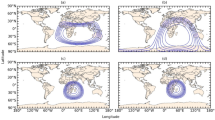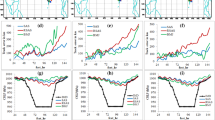Abstact
This study presents an intercomparison of four cumulus parameterization schemes (CPS) in the prediction of three cases of tropical cyclones in the north Indian Ocean. The study makes use of the Weather Research and Forecasting model of Non-hydrostatic Mesoscale Model version with a horizontal resolution of 27 km. The four deep cumulus schemes studied are (a) modified Kain–Fritsch (KF), (b) Betts–Miller–Janjic, (c) Simplified Arakawa–Schubert and (d) Grell-Devenyi Ensemble (GD) schemes. Three cases chosen for the study are unique cases with entirely different characteristics, synoptic/convective conditions and with varying levels of performance of the driving global model forecasts. The objective of the current study is to report the relative performance of the CPSs rather than the accuracy of the forecasts, under different convective conditions as reflected in the initial and boundary conditions. The study shows that generally KF scheme produced near-realistic track, intensification and the associated rainfall patterns and GD performed worst in terms of convective organisation and the sustained intensity. The impact of cumulus parameterization schemes and its performance vary widely among the three cases studied. The standard verification scores and the contribution of grid-scale precipitation towards the total rainfall by the mesoscale model are also compared between the different cases as well as the different cumulus parameterization schemes. The performance evaluation of the tropical cyclone predictions by the mesoscale model is influenced by not only the model physics but also the convective conditions as input into the model .














Similar content being viewed by others
References
Akter N, Tsuboki K (2012) Numerical simulation of cyclone Sidr using a cloud-resolving model: characteristics and formation process of an outer rainband. Mon Weather Rev 140:789–810
Arakawa A, Schubert WH (1974) Interaction of a cumulus cloud ensemble with the large-scale environment, part I. J Atmos Sci 31:674–701
Aylward RD, Dyer JL (2010) Synoptic environments associated with the training of convective cells. Weather Forecasting 25:446–464
Belanger JI, Webster PJ, Curry JA, Jelinek MT (2012) Extended prediction of north Indian ocean tropical cyclones. Weather Forecasting 27:757–769
Betts AK, Miller MJ (1993) The Betts–Miller scheme. In: The representation of cumulus convection in numerical models. Meteor Monogr No 46, Amer Meteor Soc, pp 159–164
Chen T-C, Tsay J-D, Yen M-C, Cayanan EO (2010) Formation of the Philippine twin tropical cyclones during the 2008 summer monsoon onset. Weather forecasting 25:1317–1341
Chen G, Xue H, Zhang W, Zhou X (2012) The three-dimensional structure of precipitating shallow cumuli. Part one: the kinematics. Atmos Res 112:70–78
Cram JM, Pielke RA, Cotton WR (1992) Numerical simulation and analysis of a prefrontal squall line. Part I: observations and basic simulation results. J Atmos Sci 49:189–208
Davis C, Wang W, Dudhia J, Torn R (2010) Does increased horizontal resolution improve Hurricane wind forecasts? Weather Forecasting 25:1826–1841
Deb SK, Srivastava TP, Kishtawal CM (2008) The WRF performance for the simulation of heavy precipitating event over Ahmedabad during August 2006. J Earth Sys Sci 117:589–602
Deb SK, Kishtawal CM, Pal PK (2010) Impact of Kalpana—I derived water vapour winds on Indian Ocean tropical cyclone forecasts. Mon Weather Rev 138:987–1003
Dudhia J (1989) Numerical study of convection observed during the winter monsoon experiment using a mesoscale two-dimensional model. J Atmos Sci 46:3077–3107
Evan AT, Camargo SJ (2011) A climatology of Arabian sea cyclonic storms. J Clim 24:140–158
Frank WM (1983) The cumulus parameterization problem. Mon Weather Rev 111:1859–1871
Gallus WA Jr (1999) Eta simulations of three extreme precipitation events: sensitivity to resolution and convective parameterization. Weather Forecasting 14:405–426
Gentry MS, Lackmann GM (2010) Sensitivity of simulated tropical cyclone structure and intensity to horizontal resolution. Mon Weather Rev 138:688–704
Gopalakrishnan SG, Goldenberg S, Quirino T, Zhang X, Marks F, Yeh K-S, Atlas R, Tallapragada V (2012) Toward improving high resolution numerical hurricane forecasting: influence of model horizontal grid resolution, initialisation and physics. Weather Forecasting 27:647–666
Gray WM (1968) Global view of the origin of tropical cyclones and storms. Mon Weather Rev 96:669–700
Grell GA (1993) Prognostic evaluation of assumptions used by cumulus parameterizations. Mon Weather Rev 121:764–787
Grell GA, Devenyi D (2001) Parameterized convection with ensemble closure/feedback assumptions. In: Proceedings of 9th conference on Mesoscale processes. Amer Meteor Soc, July 30–August 2, 2001, Ft Lauderdale, pp 12–16
Grell GA, Devenyi D (2002) A generalized approach to parameterizing convection combining ensemble and data assimilation techniques. Geoph Res Let 29, NO 14
Grell GA, Dudhia J, Stauffer DR (1994) A description of the fifth generation Pen State/NCAR Mesoscale Model (MM5). NCAR Tech Note NCAR/TN-398 + STR
Houze RA Jr (1977) Structure and dynamics of a tropical squall line system. Mon Weather Rev 105:1541–1567
Houze RA Jr (1997) Stratiform precipitation in region of convection: a meteorological paradox? Bull Amer Meteor Soc 78:2179–2196
Janjic ZI (1994) The step-mountain eta coordinate model: further developments of the convection, viscous sublayer and turbulence closure schemes. Mon Weather Rev 122:927–945
Janjic ZI (2000) Comments on “development and evaluation of a convective scheme for use in climate models”. J Atmos Sci 57:3636
Johnson RH, Hamilton PJ (1988) The relationship of surface pressure features to the precipitation and air flow structure of an intense midlatitude squall line. Mon Weather Rev 116:1444–1472
Kain JS (2004) The Kain–Fritsch convective parameterization: an update. J Appl Meteor 43:170–181
Kain JS, Fritsch JM (1990) A one-dimensional entraining/detraining plume model and its application in convective parameterization. J Atmos Sci 47:2784–2802
Kain JS, Fritsch JM (1993) Convective parameterization for mesoscale models: The Kain-Fritsch scheme. In: The representation of cumulus convection in numerical models. Meteor Monogr No. 24, Amer Meteor Soc, pp 165–170
Krikken F, Steenveld GJ (2012) Modelling the re-intensification of tropical storm Erin (2007) over Okhlahoma: understanding the key role of downdrafts formulation. Tellus A 64:17417. doi:10.3402/tellusa.v64i0.17417
Kuo Y-H, Reed RJ, Liu Y (1996) The ERICA IOP 5 storm, part III: mesoscale cyclogenesis and precipitation parameterization. Mon Weather Rev 124:1409–1434
Lisan Y, McPhaden MJ (2011) Ocean precondition of cyclone Nargis in the Bay of Bengal: interaction between Rossby waves, surface fresh waters and sea surface temperatures. J Phys Oceanogr 41:1741–1755
Litta AJ, Idicula SM, Mohanty UC (2011) A comparative study of convective parameterization schemes in WRF–NMM model. Int J Comp Appl 33:32–40
Ma L-M, Tan Z-M (2009) Improving the behavior of the cumulus parameterization for tropical cyclone prediction: convection trigger. Atmos Res 92:190–211
Marchok T, Rogers R, Tuleya R (2007) Validation schemes for tropical cyclones quantitative precipitation forecasts: evaluation of operational models for US land falling cases. Weather Forecasting 22:726–746
Mohandas S, Ashrit R (2009) Tropical cyclone prediction using different convective parameterization schemes in a mesoscale model. NCMRWF research report NMRF/RR/1/2011, NCMRWF (Min Earth Sciences), A-50,Sector-62, Noida, June 2011
Molinari J, Dudek M (1992) Parameterization of convective precipitation in mesoscale numerical models: a critical review. Mon Weather Rev 120:326–344
Nasrollahi N, AghaKouchak A, Li X, Hsu K, Sorooshian S (2012) Assessing the impacts of different WRF precipitation physics in hurricane simulation. Weather Forecasting 27:1003–1016
Pan H-L, W-S Wu (1995) Implementing a Mass Flux Convection Parameterization Package for the NMC Medium-Range Forecast Model. NMC Office Note No 409. [Available from NCEP, 5200 Auth Road, Washington, DC 20233]
Peng X, Tsuboki K (1997) Impact of convective parameterizations on mesoscale precipitation associated with the Baiu front. J Meteor Soc Japan 75:1141–1154
Rafy ME, Hafez Y (2008) Anomalies in meteorological fields over northern Asia and its impact on hurricane Gonu. In: Proceedings of 28th conference on hurricanes and tropical meteorology, Amer Meteor Soc, 28April–2 May 2008, Orlando, FL
Rajagopal EN, Das Gupta M, Mohandas S, George JP, Iyengar GR, Kumar DP (2007) Implementation of T254L64 global forecast system at NCMRWF. NCMRWF technical report NMRF/TR/1/2007, NCMRWF (Min Earth Sciences), A-50, Sector-62, Noida, May 2007
Rao DVB, Prasad DH (2007) Sensitivity of tropical cyclone intensification to boundary layer and convective processes. Nat Hazards 41:429–445
Roy C, Kovordanyi R (2012) Tropical cyclone track forecasting techniques—a review. Atmos Res 104–105:40–69
Schumacher RS, Johnson RH (2005) Organisation and environmental properties of extreme rain producing mesoscale convective systems. Mon Weather Rev 133:961–976
Simpson JS, Kummerow C, Tao W-K, Adler RF (1996) On the tropical rainfall measuring mission (TRMM). Meteorol Atmos Phys 60:19–36
Singh AP, Singh RP, Raju PVS, Bhatla R (2011) The impact of three different cumulus parameterization schemes on the Indian summer monsoon circulation. Int J Ocean Clim Syst 2:27–44
Spencer PL, Stensrud DJ (1998) Simulating flash flood events: importance of the subgrid representation of convection. Mon Weather Rev 126:2884–2912
Stensrud DJ, Fritsch JM (1994) Mesoscale convective systems in weakly forced large-scale environments, part III: numerical simulations and implications for operational forecasting. Mon Weather Rev 122:2084–2104
Stensrud DJ, Bao J-W, Warner TT (2000) Using initial conditions and model physics perturbations in short-range ensemble simulations of mesoscale convective systems. Mon Weather Rev 128:2077–2107
Vaidya SS (2007) Simulation of weather systems over Indian region using mesoscale models. Meterol Atmos Phys 95:15–26
Vaidya SS, Kulkarni JR (2007) Simulation of heavy precipitation over Santacruz, Mumbai on 26 July 2005, using mesoscale model. Meterol Atmos Phys 98:55–66
Wang Z (2012) Thermodynamic aspects of tropical cyclone formation. J Atmos Sci 69:2433–2451
Wang W, Seaman NL (1997) A comparison study of convective parameterization schemes in a mesoscale model. Mon Weather Rev 125:252–278
Yang M-J, Tung Q-C (2003) Evaluation of rainfall forecasts over Taiwan by four cumulus parameterization schemes. J Meteorol Soc Japan 81:1163–1183
Yang M-J, Chien F-C, Cheng M-D (2000) Precipitation parameterizations in a simulated Mei-Yu front. Terr Atmos Oceanic Sci 11:393–422
Zhang D-L (1989) The effect of parameterized ice microphysics on the simulation of vortex circulation with a mesoscale hydrostatic model. Tellus 41A:132–147
Zhang D-L, Gao K, Parsons DB (1989) Numerical simulation of an intense squall line during 10–11 June 1985 PRE-STORM. Part I: model verification. Mon Weather Rev 117:960–994
Zheng Y, Xu Q, Stensrud DJ (1995) A numerical simulation of the 7 May 1985 mesoscale convective system. Mon Weather Rev 123:1781–1799
Acknowledgments
Global and mesoscale models mentioned in this study are adopted versions from National Centre for Environment Prediction (NCEP), USA. Rainfall observations are derived daily TRMM precipitations, and observed tracks of the three tropical cyclone cases are obtained from India Meteorological Department (IMD). The authors are thankful to the two anonymous reviewers for their constructive comments in greatly improving the manuscript.
Author information
Authors and Affiliations
Corresponding author
Rights and permissions
About this article
Cite this article
Mohandas, S., Ashrit, R. Sensitivity of different convective parameterization schemes on tropical cyclone prediction using a mesoscale model. Nat Hazards 73, 213–235 (2014). https://doi.org/10.1007/s11069-013-0824-6
Received:
Accepted:
Published:
Issue Date:
DOI: https://doi.org/10.1007/s11069-013-0824-6




